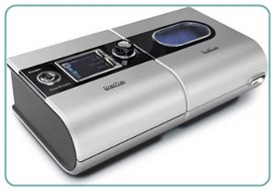CPAP and its Benefits
 Continuous positive airway pressure (CPAP) therapy for sleep apnea offers many benefits to the patient. Immediately upon initiation of therapy, the patient may feel more rested and energetic, especially if he/she presented symptoms of excessive daytime sleepiness. Snoring is eliminated with CPAP therapy, which frequently results in improved sleep for the bed partner as well as the patient. In addition to quality of life improvements for both the patient and family members, effective CPAP therapy has been demonstrated to positively affect cardiovascular and metabolic outcomes.
Continuous positive airway pressure (CPAP) therapy for sleep apnea offers many benefits to the patient. Immediately upon initiation of therapy, the patient may feel more rested and energetic, especially if he/she presented symptoms of excessive daytime sleepiness. Snoring is eliminated with CPAP therapy, which frequently results in improved sleep for the bed partner as well as the patient. In addition to quality of life improvements for both the patient and family members, effective CPAP therapy has been demonstrated to positively affect cardiovascular and metabolic outcomes.Improved Cardiovascular Outcomes with CPAP
Studies show that sleep apnea may contribute to the genesis and/or progression of coronary artery disease, heart failure, stroke and mortality. Treatment of sleep apnea with CPAP has been shown to improve cardiovascular function.
- Effective treatment of sleep apnea with CPAP leads to a significant reduction in blood pressure. Mean reduction was 10 mm Hg1, which correlates with the reduction seen with some anti-hypertensive drugs.
- CPAP therapy is associated with a reduction in risk of fatal and non-fatal cardiovascular events.
- CPAP treatment of sleep apnea has been shown to reduce the risk of new vascular events in stroke patients.
Glycemic Control with CPAP
CPAP therapy may help patients better manage their diabetes. Published findings show:
- Within two days of treatment, CPAP therapy significantly improved insulin sensitivity in patients with sleep apnea.
- In patients with type 2 diabetes, postprandial glucose levels and HbA1c levels were reduced after ~3 months of CPAP therapy.
Adherence to CPAP Therapy
As with all medical treatments, adherence to therapy is critical. Preliminary studies have indicated that achieving optimal cardiovascular and metabolic benefits from CPAP therapy requires at least 4 hours of use per night.

Benefits of Therapy. HealthySleep. Retrieved February 10, 2014 from http://www.healthysleep.com/benefits-of-therapy/.
 Although we're still at the beginning of 2014, we've already experienced some extremely cold, windy days.
Although we're still at the beginning of 2014, we've already experienced some extremely cold, windy days.